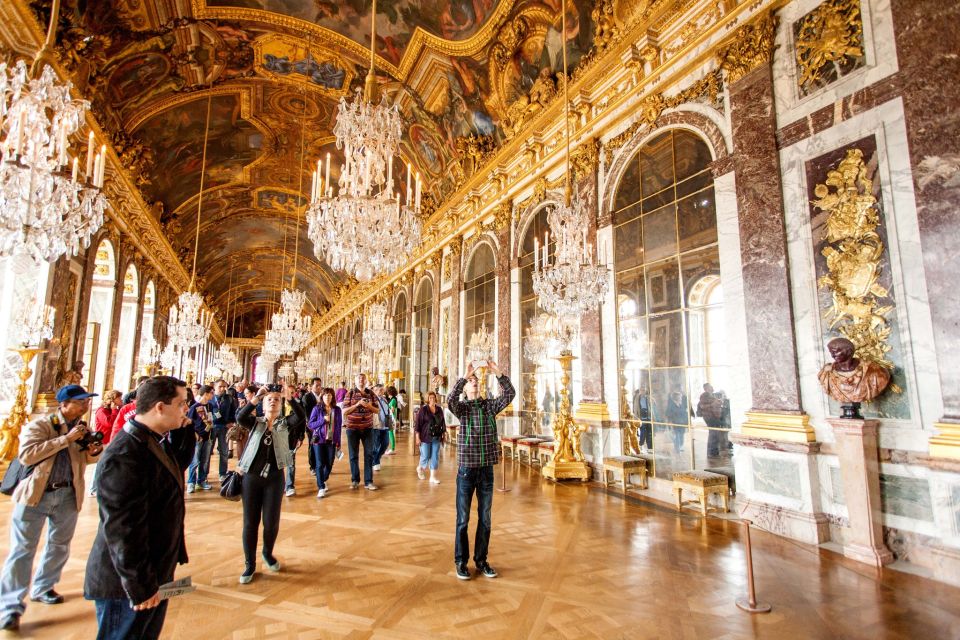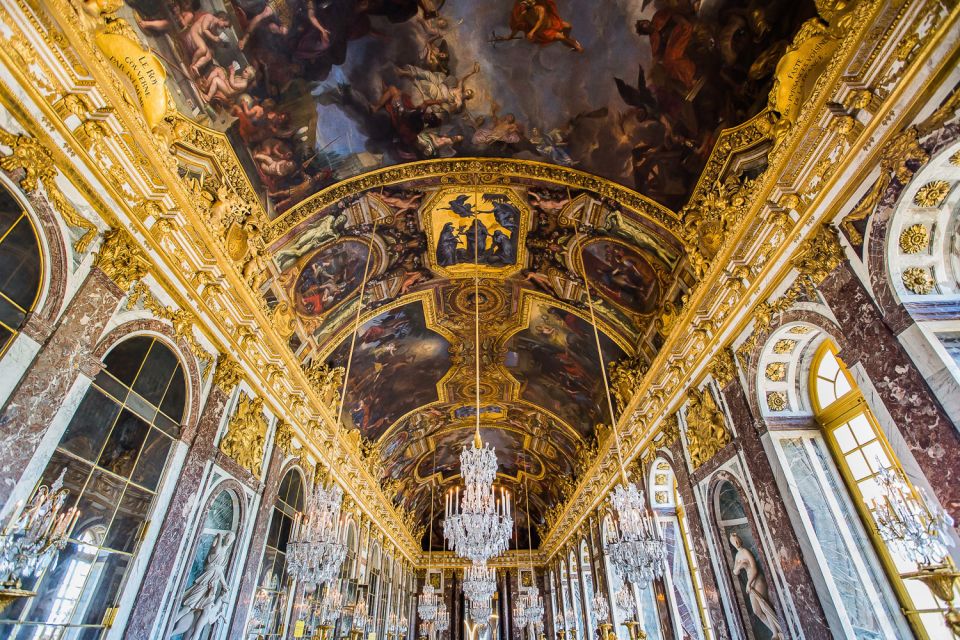The most renowned chamber in the Palace, the Hall of Mirrors at Versailles, was erected to replace a huge terrace planned by architect Louis Le Vau that opened into the garden. It’s also known as the Grande Galerie or Galerie des Glaces in French.
The terrace originally existed between the King’s Apartments to the north and the Queen’s Apartments to the south, but it was inconvenient and, above all, exposed to inclement weather, so it was demolished not long after. Jules Hardouin-Mansart, Le Vau’s successor, created a more acceptable design that replaced the terrace with a vast gallery. The construction began in 1678 and concluded in 1684.

Every year, almost ten million people visit the Palace of Versailles, and every one of them sees the Hall of Mirrors at Versailles, an aesthetic masterpiece. During the reign of the Kings, it was the most often used chamber.
The Hall of Mirrors attracts the most tourists of all the attractions at the Palace of Versailles.
The history of the Hall of Mirrors is far shorter than that of the Palace of Versailles. The Hall of Mirrors at Versailles was not originally planned for the Palace, but King Louis XIV chose to create it in 1678. He opted to merge a few rooms from the Kings and Queens’ apartments, as well as the huge terrace in front of the Palace, into one enormous space.
The Hall of Mirrors was designed by architect Jules Hardouin-Mansart, and construction began the same year. The Hall of Mirrors, arguably the most magnificent chamber in the world, was completed in six years.
The Hall of Mirrors is opulence at its finest. For something erected at the end of the 17th century – approximately 350 years ago – it is completely innovative. The seventeen mirror-clad arches that reflect the seventeen arcaded windows overlooking the Versailles gardens are the room’s defining feature.
There are twenty-one mirrors in each of the seventeen arches, for a total of 357 mirrors. If you’re wondering, “How many mirrors are there in the Hall of Mirrors?” 357 is the correct answer. The Hall of Mirrors at Versailles is 240 feet long and 34 feet broad (10.4 meters). It boasts a 40-foot (12.2-meter) high ceiling with brightly painted murals.
On the vaulted ceiling, Charles Le Brun, a well-known French artist of the time, created 30 compositions reflecting Louis XIV and France’s proud past. While the building of the Hall of Mirrors has ceased, the restoration of the structure has not.
The Hall of Mirrors at Versailles was built for two reasons by King Louis XIV. He despised the terrace and believed the huge terrace perched over the Palace of Versailles’ entryway looked odd. It was also exposed to harsh weather.
King Louis XIV desired a ‘power’ chamber while also believing that he needed a room that demonstrated France’s aesthetic, political, and economical supremacy to the rest of the world.
Experts think the King and his architect intended for the numerous paintings depicting his achievements on the ceiling to portray political dominance. The financial superiority was demonstrated by the use of 357 mirrors, which were costly extravagances at the time.
The sculptures, furniture, and other items of art that adorned the Hall of Mirrors demonstrated creative mastery.

The King utilized the Palace of Versailles’ mirror room for a variety of reasons. It was used on a regular basis as a waiting and meeting area for courtiers and guests. They might also catch a sight of the King as he traveled between his many rooms from this room.
In the Hall of Mirrors, courtiers and guests who did not have direct access to the King may say something or leave a letter for him. It also held lavish events including royal weddings, ceremonial balls, and diplomatic banquets, among others.
Throughout the building of the Hall of Mirrors at Versailles, King Louis XIV remained firm in his demands. “Every material used should be created in France,” he stressed. The architect of Hall of Mirrors, Jules Hardouin-Mansart, had an issue with this proposal.
His design for the House of Mirror necessitated a large number of mirrors, and Venice had a monopoly on mirrors at the time. As a workaround, the French persuaded a few Venetian artisans to defect to their country. The Hall of Mirrors, as we know it now, was created by these artisans.
The Venetian authorities ordered the death of the artists who had assisted the French in order to preserve the art of mirror manufacture a secret. There is no indication that the assassinations were successful, but there is also no proof that they were not. As a result, the Hall of Mirrors is frequently referred to as the ‘Hall of Bloody Mirrors.’
It is safe to claim that the Versailles mirror room has aided in the conclusion of numerous conflicts by serving as the site of treaty signings. The Treaty of Paris, for example, was signed in 1783 between the United Kingdom and the United States of America. The Revolutionary War came to an end as a result of this pact. Britain recognized the United States of America as an independent entity under the conditions of the treaty.
France was humbled in the Franco-Prussian war a little less than a century later, in 1871. In the Hall of Mirrors, Kaiser Wilhelm I was acclaimed as Emperor of Germany as France conceded defeat at the Palace of Versailles. The Treaty of Versailles was signed in the Hall of Mirrors over 50 years later.
It was signed on June 28, 1919, and it marked the conclusion of World Fight 1 by ending the war between Germany and the Allied Powers. Interestingly, French Prime Minister Clemenceau picked the Hall of Mirrors to sign the Treaty of Versailles after the Allies conquered Germany. In the same area in 1871, he sought poetic justice and retribution for France’s surrender to Germany!
All Palace of Versailles Tickets includes admission to the Palace of Versailles Mirror Room. Purchasing tickets for the Palace of Versailles online helps you save money, time, and energy. Many people choose to travel from Paris to Versailles by bus or rail, which includes entry to the Palace of Versailles.
The five methods to explore the Palace of Versailles are listed below (and Hall of Mirrors).
If you only have a limited amount of time, consider purchasing tickets that get you entry to the Palace of Versailles (Hall of Mirrors is in the Palace and is included in this ticket).
Choose the All Areas of the Versailles Palace Tour if you want a more complex experience and have at least six hours to spare. The Fountain Shows and Musical Gardens are an extra attraction if you visit during the busy tourist season.
The Versailles Palace and Hall of Mirrors are included in the Fountain Shows and Musical Gardens ticket. The majority of seasoned travelers prefer to be escorted by a local guide. If you’re one of them, our Versailles Skip The Line Guided Tour is for you.
Because the Versailles Estate is 20 kilometers (12 miles) from Paris, some people choose to go to Versailles by rail or air-conditioned carriage.
Also Visit: Louvre Museum